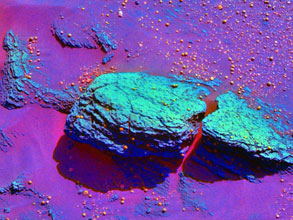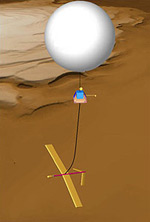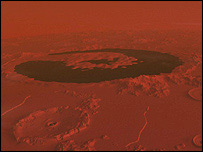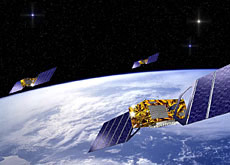[Previous entry: "learn-economics"] [Next entry: "Titan AE"]
15/02/2004: "Of Mars and Men"
 Opportunity and Spirit are continuing their scientific work on Mars and sending back stunning pictures and their discoveries. After overcoming some technical difficulties, both probes are now fully operational. The picture shows a colour-enhanced rock, highlighting the spherules covering the outcrop's surface near Opportunity.
Opportunity and Spirit are continuing their scientific work on Mars and sending back stunning pictures and their discoveries. After overcoming some technical difficulties, both probes are now fully operational. The picture shows a colour-enhanced rock, highlighting the spherules covering the outcrop's surface near Opportunity.
Some issues intrinsic to Mars' hosting environment still represent challenges for the mission, such as the effects of extreme cold while the sun is not exposing the probes, or manoeuvering the probes on a sand-covered slope to counter the effects of drifting.
All this is fascinating to me. As I was walking home a few nights ago, I could see Mars bright in the sky and realised that 2 human probes were at work on the planet's surface under the watchful eye of a few orbiting satellites. Of all people walking home that night, I think I was the only one impressed. Another project for a mission to Mars is the Nasa-funded StratoSail. Like weather balloons, the StratoSail could carry cameras and gadgets to spot potential areas for human missions.
Another project for a mission to Mars is the Nasa-funded StratoSail. Like weather balloons, the StratoSail could carry cameras and gadgets to spot potential areas for human missions.
In theory, the balloon could be steered for months in Mars' atmosphere. The low cost of the balloon, low energy consumption and versatile operation makes it a very attractive project. However, issues of manoeuverability in strong wind currents still represent a challenge. Something to follow... The Huygens probe to Titan is currently hurtling through space attached to another spacecraft, Cassini. Launched in 1997, they will arrive at Saturn on 1 July this year. Cassini will spend four years in orbit around the giant planet, and when it approaches Titan next January, it will release the little Huygens for its trip down to the surface.
The Huygens probe to Titan is currently hurtling through space attached to another spacecraft, Cassini. Launched in 1997, they will arrive at Saturn on 1 July this year. Cassini will spend four years in orbit around the giant planet, and when it approaches Titan next January, it will release the little Huygens for its trip down to the surface.
The probe, a joint mission between the US and European space agencies, will focus on the oily oceans of methane and ethane which researchers believe cover much of the surface. The mission will help better understand the physics of climate change and oceans. Finally, closer to Earth, Switzerland is slowly making up its mind whether to join the ESA's Galileo project, a European satellite positioning system to compete against the US GPS.
Finally, closer to Earth, Switzerland is slowly making up its mind whether to join the ESA's Galileo project, a European satellite positioning system to compete against the US GPS.
Unlike the American model, the European system will be controlled by a civilian body and will not suffer from signal restrictions, allowing it to give highly precise positioning in time and space. Despite being controlled by civilians, Brussels has not ruled out military applications for Galileo.
The European Commission recently announced that its space projects would be closely linked to a possible EU security and defence force. Galileo would enable EU forces to monitor the movement of troops and munitions.


